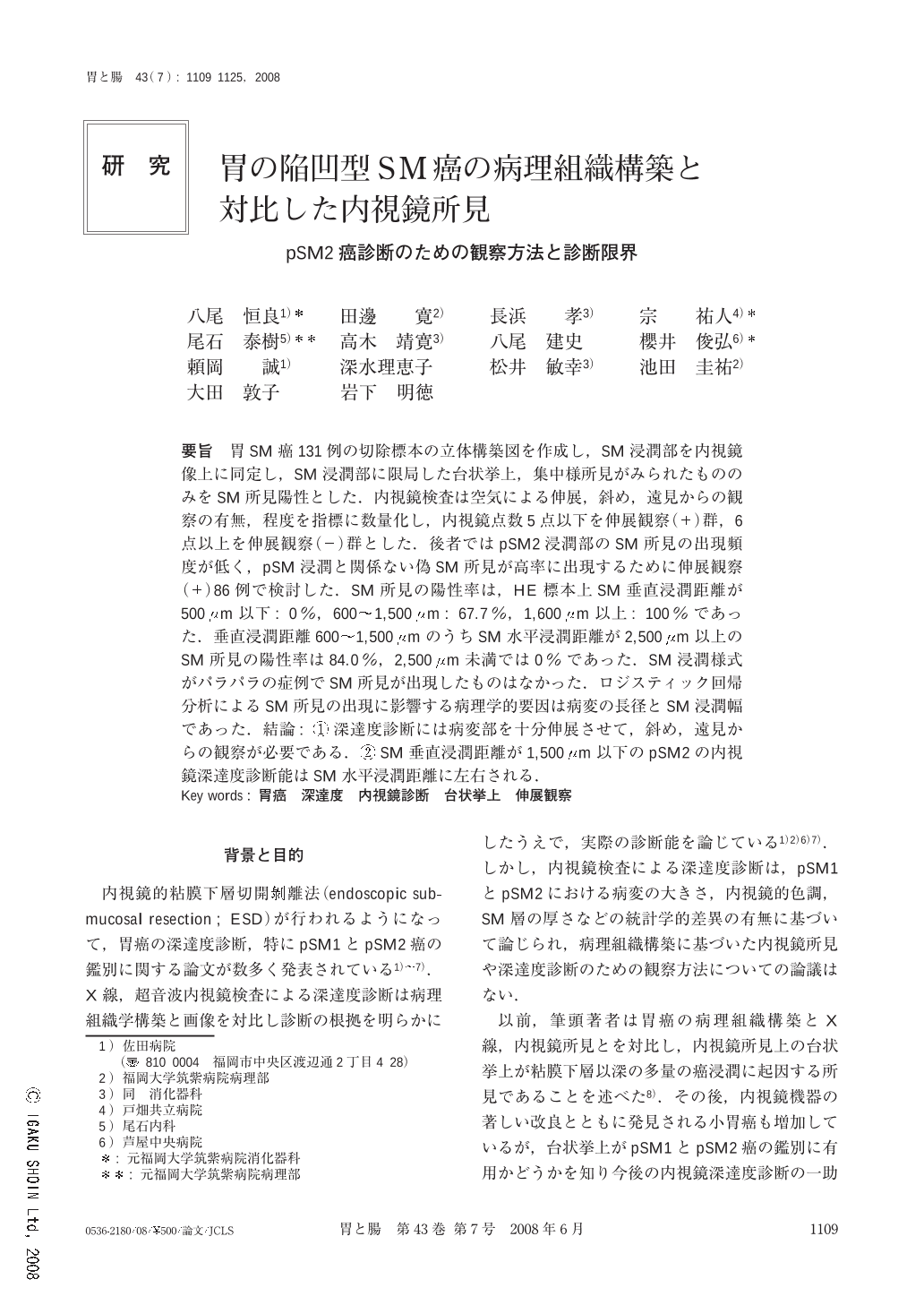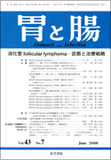Japanese
English
- 有料閲覧
- Abstract 文献概要
- 1ページ目 Look Inside
- 参考文献 Reference
- サイト内被引用 Cited by
要旨 胃SM癌131例の切除標本の立体構築図を作成し,SM浸潤部を内視鏡像上に同定し,SM浸潤部に限局した台状挙上,集中様所見がみられたもののみをSM所見陽性とした.内視鏡検査は空気による伸展,斜め,遠見からの観察の有無,程度を指標に数量化し,内視鏡点数5点以下を伸展観察(+)群,6点以上を伸展観察(-)群とした.後者ではpSM2浸潤部のSM所見の出現頻度が低く,pSM浸潤と関係ない偽SM所見が高率に出現するために伸展観察(+)86例で検討した.SM所見の陽性率は,HE標本上SM垂直浸潤距離が500μm以下:0%,600~1,500μm:67.7%,1,600μm以上:100%であった.垂直浸潤距離600~1,500μmのうちSM水平浸潤距離が2,500μm以上のSM所見の陽性率は84.0%,2,500μm未満では0%であった.SM浸潤様式がパラパラの症例でSM所見が出現したものはなかった.ロジスティック回帰分析によるSM所見の出現に影響する病理学的要因は病変の長径とSM浸潤幅であった.結論:①深達度診断には病変部を十分伸展させて,斜め,遠見からの観察が必要である.②SM垂直浸潤距離が1,500μm以下のpSM2の内視鏡深達度診断能はSM水平浸潤距離に左右される.
Aim: The aim of this study was to investigate how we can make a correct diagnosis of submucosal invasion of early gastric cancer by endoscopic findings alone and to determine the optimal condition of endoscopic observation for obtaining an accurate diagnosis.
Methods: One-hundred and thirty-one early gastric cancers with submucosal invasion of depressed-type, which had been resected endoscopically or surgically, and which had been fully investigated pathologically, were included in this study. The cancers were classified into two subgroups according to depth of invasion in the resected specimen, namely, pSM1≦500 micrometers (43 lesions) and pSM2>500 micrometers (88 lesions).
First, we reconstructed the extent of the carcinoma together with the depth of invasion on a macroscopic photo of the resected specimen in order to identify accurately the site of the submucosal invasion within the lesion, and then, we reviewed the endoscopic findings and investigated the following subjects: (1) Optimal conditions of endoscopic observation which are suitable for correctly diagnosing the depth of carcinoma, (2) The prevalence of the endoscopic findings (massive elevation or mucosal convergence with elevation) for predicting pSM2; and (3) The histopathological findings which correlate with the positive findings of submucosal invasion by endoscopic findings.
Results: (1) The optimal endoscopic condition for making a correct diagnosis of submucosal invasion was an oblique and distant overview after extending the gastric wall with enough air. (2) Under such a condition, no pSM1 cancers showed findings of submucosal invasion. In contrast, the prevalence of those positive findings in pSM2 cancers differed depending upon the width of the submucosal invasion, that is, the prevalence of positive findings in pSM2 cancers which had invaded to a width of≧2,500 micrometers and<2,500 micrometers were 84.0%and 0%, respectively. (3) With the regard to the infiltrating pattern of the carcinoma, the massive invasive pattern correlated with positive endoscopic findings of submucosal invation, while the carcinoma with sparse invasive pattern did not demonstrate any positive endoscopic findings of submucosal invasion.
Conclusion: (1) The most important histological finding which can contribute to the endoscopic diagnosis of submucosal invasion was the width of the submucosal invasion. (2) In order to make an accurate diagnosis of depth of invasion, it is to extend the gastric wall by inflating sufficient air during the endoscopic examination.

Copyright © 2008, Igaku-Shoin Ltd. All rights reserved.


